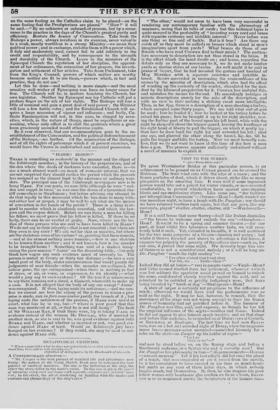"BLOOD BLOOD!"
THERE is something so recherche in the manner and the object of the Edinburgh murders ; in the history of the perpetrators, and of the den where the deeds of darkness were executed, there is—to use a much abused word—so much of romantic interest, that we are not surprised they should outlive the period which the proverb has assigned as the utmost limit to the existence of ordinary won- ders. The principal aim of the Edinburgh newspapers now is to hang HARE. For our parts, we care little although he were " sod- den and suppit in broo," as was once the doom of a tyrannical she- riff somewhere in Strathmore; but before advising any attempt to do that legally to this miscreant which he has done to many with- out either law or gospel, it may be well to ask what are the means of conviction in the hands of the public ? There is a thing in re- gard to murder which is absolutely essential, and which the law- yers call the corpus delicti. Before we can hang a man for killing . his fellow, we must prove that his fellow is killed. If there be no body, there can be no verdict of guilty. Now, where are the bo- dies of those persons who are said to have been killed by HARE? We do not say in their integrity—that is not essential ; but where are they even in any state ? We ask not for skin or muscles, but where are the skeletons even of his victims ? or, granting that these remain, —and at the utmost nothing more remains,—how is one skeleton to be known from another ; and if not known, how is the murder to be brought home ? Something was said of a student recog- nizing the poor maniac " Jamie" on the dissecting table,—but only think how vague any such evidence must of necessity be. The person is seated at twenty or thirty feet distance ;—he sees a very small part of the body, under circumstances that would puzzle the judgments of near friends—when the muscles are collapsed, the colour gone, the eye extinguished—when there is nothing in fact of dress, or air, or voice, or expression, to fix identity ;—what would a jury say to such evidence ? Of the rest it is unnecessary to say there remains not a shred, a filament, wherewith to make up a ease. It is not alleged that the body of any one except" Jamie" was recognized. If then, laying aside its usifairness,—and we con- fess we cannot see how the villany of the person to whom a pro- mise is made, can in foro conscientice justify the breach of it ; but laying aside the unfairness of the process, if HARE were sisted in court, what has he to say, but—" where is your proof that this man was murdered at all, or that he is not still living ?" The fault of Sir Wientasi RAE, if fault there were, lay in taking Hans: as evidence instead of the woman Mc Dou GAL, who if married to another man, as she is said to be, was good evidence against both BURKE and HARE, and whether so married or not, was good evi- dence against HARE at least. Would an Edinburgh jury have hanged on her evidence ? If they would, she may be used as evi- dence against HARE Still.


















 Previous page
Previous page